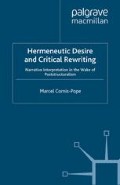Abstract
In what follows I will discuss seven readings of ‘The Figure in the Carpet’ developed by the members of my critical theory seminar. Six of these papers appeared in the Draftings in Reader-Oriented Criticism issue (DIROC). My own analysis, presented midway through this seminar, but fully articulated only in this chapter, is added here in order to represent more accurately my own obtrusive presence in this community of readers. Three other papers were left out from the Draftings collection because they remained at an incipient level of critical articulation. From the theoretical perspective adopted in this seminar, emphasising the interactional, open-ended process of critical writing,1 this did not meant that they were not ‘finished’, but rather that they did not pursue the interaction with James’s story and other readings far enough, did not foreground their own configurational process sufficiently. The primary purpose of this seminar, and of the publication venture that followed it, was to provide ample opportunity for the articulation of self-conscious, positional readings that engaged in a critical dialogue with James’s text and with each other. These essays could follow, as indeed most of them have, established modes of critical articulation, or they could resort to deconstructive, ironic, parataxical procedures in order to fulfill their purposes. Students were also encouraged to seek some degree of self-awareness, to spell out the assumptions and critical operations that led from early response to critical ‘rewriting’. Ideally, after several weeks of intense rewriting and classroom discussion, all interpretations can attain this ‘bi-active’ critical focus on textual figuration and their own interpretive manoeuvres. The three papers left out did not manage to make it beyond the level of a good response report or a formalistic application of a readily available interpretative grid (in this case borrowed from Peircean semiotics).
‘The Figure in the Carpet’ exhibits a small group of well-meaning persons engaged in a test. The reader is, on the evidence, left to conclude.
Henry James, The Art of the Novel (p. 229)
… If my account of meaning is correct, it must disqualify its own closure: analytic discourse is as self-differing, its truths as slippery, as any literary work. This is the obverse side of Barthes’ dialectic of paradox: we can no more impose petrification than we can avoid it.
William Ray, Literary Meaning (p. 206)
Access this chapter
Tax calculation will be finalised at checkout
Purchases are for personal use only
Preview
Unable to display preview. Download preview PDF.
Notes and References
Northrop Frye, Anatomy of Criticism (Princeton: Princeton University Press, 1973), p. 74.
A naturalistic style is bound to be the result… The particular form this principle of naturalistic arbitrariness, this lack of hierarchic structure, may take is not decisive. We encounter it in the all-determining “social conditions” of Naturalism, in Symbolism’s impressionistic methods and its cultivation of the exotic, in the fragmentation of objective reality in Futurism and Constructivism, and the German Neue Sachlichkeit, or, again, in Surrealism’s stream of consciousness.’ Georg Lukács, ‘The Ideology of Modernism’, in The Meaning of Contemporary Realism, trans. John and Necke Mander (London: Merlin Press, 1963), p. 34.
Jürgen Habermas, ‘Modernity — An Incomplete Project’, in The Anti-Aesthetic: Essays on Postmodern Culture, ed. Hal Foster (Port Townsend: Bay Press, 1983), 3–15.
J.M. Berstein, The Philosophy of the Novel: Lukacs, Marxism and the Dialectics of Form (Minneapolis: University of Minnesota Press, 1984), p. 234.
Peter W. Lock, ‘“The Figure in the Carpet”: The Text as Riddle and Force,’ Nineteenth-Century Fiction, 36 (1981): 158.
Jean Baudrillard, For a Critique of the Political Economy of the Sign, trans. with an intro Charles Levin (St. Louis, Mo: Telos Press, 1981), p. 88.
Henry James, Notes of a Son and Brother (New York: Scribner’s, 1914), p. 87.
Peter Brooks, The Melodramatic Imagination: Balzac, Henry James, Melodrama and the Mode of Excess (New Haven and London: Yale University Press, 1976), p. 19.
Jonathan Culler, Ferdinand de Saussure, rev. ed. (Ithaca: Cornell University Press, 1986), p. 128.
Erving Goffman, Forms of Talk (Philadelphia: University of Pennsylvania, 1983), p. 134.
Ronald Adler and George Rodman, Understanding Human Communication (New York: Holt, Rinehart, and Winston, 1985), p. 9.
Wallace Martin, Recent Theories of Narrative (Ithaca: Cornell University Press, 1986), p. 190.
Jean-François Lyotard, The Postmodern Condition: A Report on Knowledge, trans. Geoff Bennington and Brian Massumi (Minneapolis: University of Minnesota Press, 1984), p. 10.
F.O. Matthiessen, Introduction to Henry James, Stories of Writers and Artists (New York, New Directions, 1944), p. 6.
Naomi Schor, Reading in Detail: Aesthetics and the Feminine (New York and London: Methuen, 1987).
Roland Barthes, ‘The Pleasure of the Text’, A Barthes Reader, ed. Susan Sontag (New York: Hill and Wang, Strauss and Giroux, 1982), pp. 410–11.
Jacques Lacan, ‘Discours de clôture des journées sur les psychoses chez l’enfant’, Recherches, 11 (1968): 145–6.
Elaine Showalter, ‘Piecing and Writing’, in The Poetics of Gender, ed. Nancy K. Miller (New York: Columbia University, 1986), p. 226.
Author information
Authors and Affiliations
Copyright information
© 1992 Marcel Cornis-Pop
About this chapter
Cite this chapter
Cornis-Pope, M. (1992). Stringing ‘The Figure in the Carpet’: Seven Readings, Seven Critical Plots. In: Hermeneutic Desire and Critical Rewriting. Palgrave Macmillan, London. https://doi.org/10.1057/9780230371378_7
Download citation
DOI: https://doi.org/10.1057/9780230371378_7
Publisher Name: Palgrave Macmillan, London
Print ISBN: 978-1-349-38930-8
Online ISBN: 978-0-230-37137-8
eBook Packages: Palgrave Literature & Performing Arts CollectionLiterature, Cultural and Media Studies (R0)

